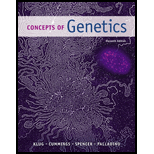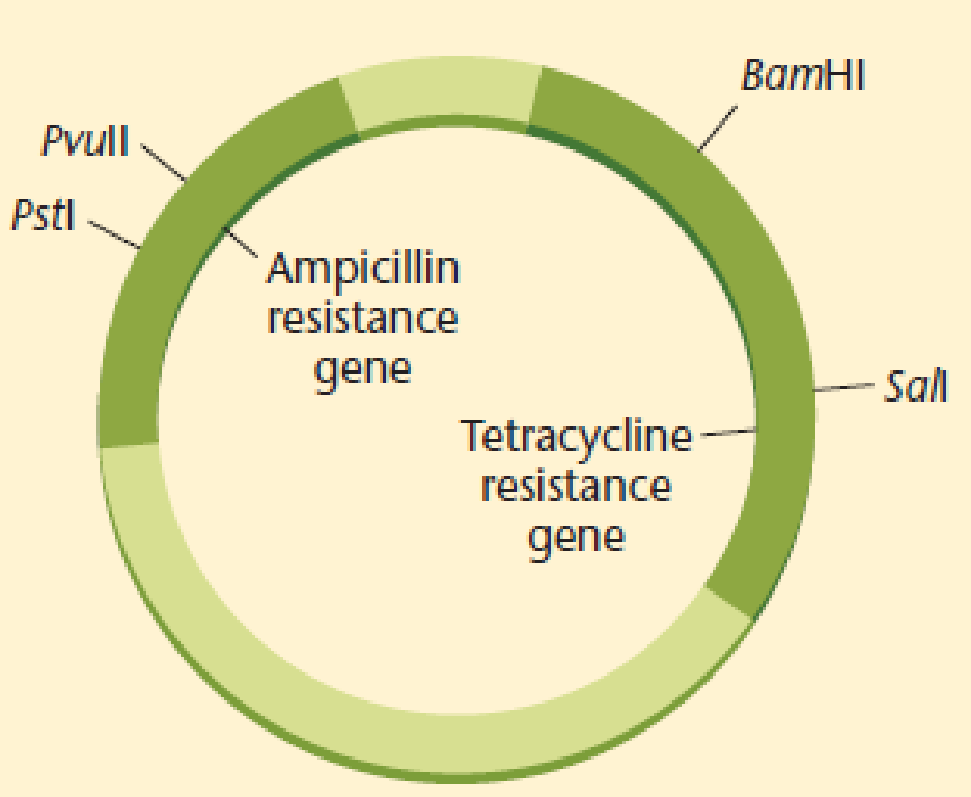
Concept explainers
A plasmid that is both ampicillin and tetracycline resistant is cleaved with Pstl, which cleaves within the ampicillin resistance gene. The cut plasmid is ligated with Pstl-digested Drosophila DNA to prepare a genomic library, and the mixture is used to transform E. coli K12.

- (a) Which antibiotic should be added to the medium to select cells that have incorporated a plasmid?
- (b) If recombinant cells were plated on medium containing ampicillin or tetracycline and medium with both antibiotics, on which plates would you expect to see growth of bacteria containing plasmids with Drosophila DNA inserts?
- (c) How can you explain the presence of colonies that are resistant to both antibiotics?
(a)
To determine: The antibiotic that an individual should add to the medium to select cells that contain the recombinant plasmid.
Introduction: Plasmid refers to an circular, extrachromosomal DNA (deoxyribonucleic acid) molecule that replicates chromosome independently.
Explanation of Solution
The gene that confers resistance to tetracycline is intact in the recombinant plasmid. An individual would add tetracycline to the medium to select the recombinant plasmd in the cells. In the medium, the bacteria that have been transformed with recombinant plasmid will be resistant to tetracycline.
Thus, an individual would use tetracycline to select cells that contain the recombinant plasmid.
(b)
To determine: The plates on which an individual might see the growth of bacteria having plasmids with Drosophila DNA inserts.
Introduction: Genetically modified bacterial plasmids were the first developed vectors, used for cloning purpose.
Explanation of Solution
Cloning is a important process in which bacterial cells containing recombinant DNA can be readily identified. This process is also accomplished is through the use of selectable marker genes. Antibiotic resistant genes provide very effective selectable marker genes. Therefore, the colonies that grow on tetracycline medium but do not grow on ampicillin medium would contain the Drosophila DNA insert.
Thus, colonies that only grow in tetracycline medium probably contain the Drosophila DNA insert.
(c)
To determine: The reason that some colonies can grow on tetracycline medium as well as ampicillin medium.
Introduction: Plasmids have an origin of replication (ori) site, which makes it possible to produce several hundred copies of a plasmid in a single host cell.
Explanation of Solution
When performing cloning process, it is not necessary for incorporation of all DNA plasmids need to be cloned. A plasmid cut with a restriction enzyme generating sticky ends can self-ligate if cut ends of the plasmid rejoin. Also, if cleavage with PstI was incomplete, then no change in biological characteristics of the uncut plasmid would be expected.
Thus, self-ligation of plasmid and incomplete cleavage with PstI are responsible for the growth of colonies that are resistant to both antibiotics.
Want to see more full solutions like this?
Chapter 20 Solutions
Concepts of Genetics (11th Edition)
- Draft a science fair project for a 11 year old based on the human body, specifically the liverarrow_forwardYou generate a transgenic mouse line with a lox-stop-lox sequence upstream of a dominant-negative Notch fused to GFP. Upon crossing this mouse with another mouse line expressing ectoderm-specific Cre, what would you expect for the phenotype of neuronal differentiation in the resulting embryos?arrow_forwardHair follicle formation is thought to result from a reaction-diffusion mechanism with Wnt and its antagonist Dkk1. How is Dkk1 regulated by Wnt? Describe specific cis-regulatory elements and the net effect on Dkk1 expression.arrow_forward
- Limetown S1E4 Transcript: E n 2025SP-BIO-111-PSNT1: Natu X Natural Selection in insects X + newconnect.mheducation.com/student/todo CA NATURAL SELECTION NATURAL SELECTION IN INSECTS (HARDY-WEINBERG LAW) INTRODUCTION LABORATORY SIMULATION A Lab Data Is this the correct allele frequency? Is this the correct genotype frequency? Is this the correct phenotype frequency? Total 1000 Phenotype Frequency Typica Carbonaria Allele Frequency 9 P 635 823 968 1118 1435 Color Initial Frequency Light 0.25 Dark 0.75 Frequency Gs 0.02 Allele Initial Allele Frequency Gs Allele Frequency d 0.50 0 D 0.50 0 Genotype Frequency Moths Genotype Color Moths Released Initial Frequency Frequency G5 Number of Moths Gs NC - Xarrow_forwardWhich of the following is not a sequence-specific DNA binding protein? 1. the catabolite-activated protein 2. the trp repressor protein 3. the flowering locus C protein 4. the flowering locus D protein 5. GAL4 6. all of the above are sequence-specific DNA binding proteinsarrow_forwardWhich of the following is not a DNA binding protein? 1. the lac repressor protein 2. the catabolite activated protein 3. the trp repressor protein 4. the flowering locus C protein 5. the flowering locus D protein 6. GAL4 7. all of the above are DNA binding proteinsarrow_forward
- What symbolic and cultural behaviors are evident in the archaeological record and associated with Neandertals and anatomically modern humans in Europe beginning around 35,000 yBP (during the Upper Paleolithic)?arrow_forwardDescribe three cranial and postcranial features of Neanderthals skeletons that are likely adaptation to the cold climates of Upper Pleistocene Europe and explain how they are adaptations to a cold climate.arrow_forwardBiology Questionarrow_forward
- ✓ Details Draw a protein that is embedded in a membrane (a transmembrane protein), label the lipid bilayer and the protein. Identify the areas of the lipid bilayer that are hydrophobic and hydrophilic. Draw a membrane with two transporters: a proton pump transporter that uses ATP to generate a proton gradient, and a second transporter that moves glucose by secondary active transport (cartoon-like is ok). It will be important to show protons moving in the correct direction, and that the transporter that is powered by secondary active transport is logically related to the proton pump.arrow_forwarddrawing chemical structure of ATP. please draw in and label whats asked. Thank you.arrow_forwardOutline the negative feedback loop that allows us to maintain a healthy water concentration in our blood. You may use diagram if you wisharrow_forward
 Biology Today and Tomorrow without Physiology (Mi...BiologyISBN:9781305117396Author:Cecie Starr, Christine Evers, Lisa StarrPublisher:Cengage Learning
Biology Today and Tomorrow without Physiology (Mi...BiologyISBN:9781305117396Author:Cecie Starr, Christine Evers, Lisa StarrPublisher:Cengage Learning Biology: The Dynamic Science (MindTap Course List)BiologyISBN:9781305389892Author:Peter J. Russell, Paul E. Hertz, Beverly McMillanPublisher:Cengage Learning
Biology: The Dynamic Science (MindTap Course List)BiologyISBN:9781305389892Author:Peter J. Russell, Paul E. Hertz, Beverly McMillanPublisher:Cengage Learning Human Heredity: Principles and Issues (MindTap Co...BiologyISBN:9781305251052Author:Michael CummingsPublisher:Cengage Learning
Human Heredity: Principles and Issues (MindTap Co...BiologyISBN:9781305251052Author:Michael CummingsPublisher:Cengage Learning Concepts of BiologyBiologyISBN:9781938168116Author:Samantha Fowler, Rebecca Roush, James WisePublisher:OpenStax College
Concepts of BiologyBiologyISBN:9781938168116Author:Samantha Fowler, Rebecca Roush, James WisePublisher:OpenStax College Human Biology (MindTap Course List)BiologyISBN:9781305112100Author:Cecie Starr, Beverly McMillanPublisher:Cengage LearningCase Studies In Health Information ManagementBiologyISBN:9781337676908Author:SCHNERINGPublisher:Cengage
Human Biology (MindTap Course List)BiologyISBN:9781305112100Author:Cecie Starr, Beverly McMillanPublisher:Cengage LearningCase Studies In Health Information ManagementBiologyISBN:9781337676908Author:SCHNERINGPublisher:Cengage





